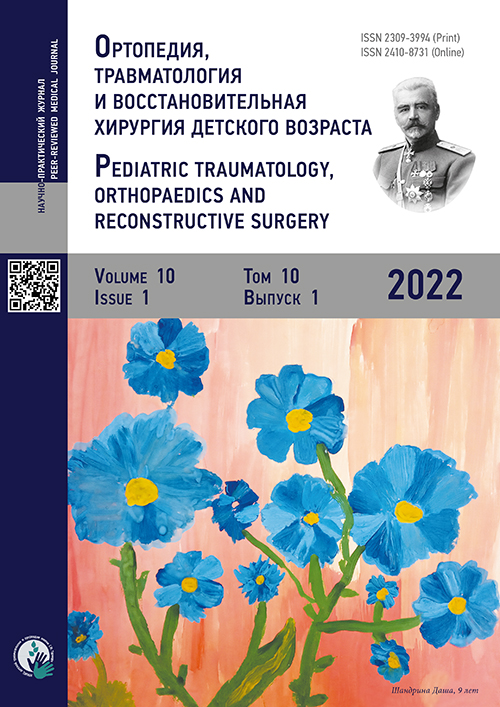卷 10, 编号 1 (2022)
- 年: 2022
- ##issue.datePublished##: 24.03.2022
- 文章: 11
- URL: https://journals.eco-vector.com/turner/issue/view/5125
- DOI: https://doi.org/10.17816/PTORS.101
Clinical studies
研究青少年肌肉骨骼疾病的结构与躯体病理学及其生活环境的关系
摘要
论证。在年轻一代的健康疾病中,肌肉骨骼系统的病理占有一个领先的位置。随着儿童的成长,其发病频率也会增加,在这方面,需要仔细监测、预防和长期康复措施。
本研究的目的研究肌肉骨骼病变的发生率,同时考虑到在不同环境下长大的青少年的身体病变,以便决定预防和补救措施。
材料与方法。主要组包括来自社会护理机构的11–15岁的学童(n=60)。对照组包括来自完整家庭的儿童(n=60)。根据儿童和青少年卫生研究所制定的方法建议对健康进行了评估。该材料是从表格112/y,003/y,026/y中复制的临床检查结果和其他专家的结论。统计学处理采用Pearson χ2标准,p<0.05时采用Yates校正。
结果。来自社会机构的儿童的健康状况明显比来自完整家庭的儿童差(p=0.04)。他们患慢性疾病的可能性比正常人高4.8倍(p=0.04),其中,中枢神经和肌肉骨骼系统、消化器官、血液循环和耳鼻喉科器官的障碍居多(p=0.001)。肌肉骨骼系统的病变通常是合并性质的(p=0.02)。在对照组中,功能障碍较多(p=0.04),消化和循环器官疾病占多数。肌肉骨骼系统的病理占第三位,且明显较少见(p=0.0001)。
结论。来自社会机构的儿童的健康状况比来自完整家庭的学童差。在来自社会机构的儿童中,肌肉骨骼系统病变占第二位,合并病变的频率较高,增加的骨科病理主要发生于脊柱侧凸,扁平足和姿态障碍,脊柱侧凸结构以神经发育不良和特发性形式为主。患有脊柱侧弯的儿童多被诊断为中枢神经系统、消化系统和循环系统疾病;患有扁平足的儿童被诊断为消化系统和循环系统疾病;患有姿势障碍的儿童被诊断为耳鼻喉科、循环系统和视觉疾病。肌肉骨骼系统的病理应考虑作为一个跨学科的问题,因此一个全面的康复计划与其他专家的参与是必要的。
 5-12
5-12


股骨近端多平面畸形儿童矢状面平衡的放射学指标研究
摘要
论证。儿童股骨近端多平面畸形常伴有大转子的高位,引起髋关节生物力学和关节外撞击综合征。股骨近端多侧畸形的渐进式解剖和生物力学变化也导致髋关节与骨盆与腰骶椎系统的变化,相互加重。目前,俄罗斯文献中很少有关于评估患有这种病症的儿童的矢状椎体-骨盆关系的文章。
本研究的目的是评估股骨近端多平面畸形且大转子位置较高的儿童的矢状面平衡的放射学指标。确定儿童股骨近端畸形的严重程度与脊柱-骨盆参数的变化之间的关系。
材料与方法。对25例9至15岁股骨近端畸形患儿(25个受累关节)的X线检查资料进行分析。该患儿的股骨大转子位于股骨上极高位,其尖端位于股骨头上极或以上。正面的股骨头与大转子的比率以及矢状面的平衡值是在侧面的骨骼X光片上评估的。获得的数据经过了统计学处理。
结果。股骨近端多平面畸形且大转子位置较高的患儿,其特点是整体腰椎前凸和骨盆过度前倾值显著增加,以及骨盆向患肢倾斜。发现股骨近端损伤的严重程度与矢状脊柱-骨盆比率的变化程度之间有直接的相关性。
结论。大转子高位儿童髋关节解剖障碍的合并和进展导致腰骶椎的病理代偿性改变,并发展为退行性营养不良。
 23-32
23-32


大胸肌和背阔肌单极移植恢复肌肉发育不良儿童前臂主动屈曲效果的比较分析
摘要
论证。肌肉发育不良儿童前臂缺乏主动屈曲可导致严重的功能障碍。为了恢复这类患者自助治疗的可能性,在前臂屈肌的位置进行各种供体部位的肌肉移植。
本研究的目的是通过对比分析将大胸肌和背阔肌转位到前臂屈肌位置的结果,来确定恢复肌肉发育不良患儿肘关节主动屈曲的最佳供体区域。
材料与方法。这项回顾性研究包括61名肌萎缩症患者:30名(49%)女孩和31名(51%)男孩。 2011年至2020年,参加研究的儿童在俄罗斯联邦卫生部H. Turner National Medical Research Center for Children’s Orthopedics and Trauma Surgery接受检查和治疗。90个病例恢复了主动前臂屈曲,其中46人(51.1%)使用大胸肌作为移植,44人(48.9%)使用背阔肌。在这两组中,都进行了单极移植。在背阔肌的情况下,采取了整个肌肉,而在大胸肌的情况下,只采取了远端部分和腹直肌筋膜的一个片段。术前及术后6个月及以上对患者进行临床检查。统计数据处理采用Statistica 10和SAS JMP 11应用软件包。
结果。手术时患者的年龄为1.5至15.5岁(6.24±4.24岁),术后随访为6至99个月(41.25±30.19个月)。 (41.25±30.19个月)。两组患者在随访时都出现了肘部的屈曲挛缩,但与大胸肌相比,使用背阔肌作为供体肌肉时,挛缩程度较小(分别为15.19±13.04和23.24±15.37°,p=0.0483)。此外,在移植背阔肌后,前臂屈肌力量平均比移植大胸肌后大1分(分别为2.85±1.08和4.00±0.62,p<0.0001)。与大胸肌的移植相比,背阔肌在肘部实现了更大的主动运动幅度(分别为75.37±17.86和55.88±24.60°, p=0.0022)。
结论。本研究证实了肌肉发育不良患者使用背阔肌和大胸肌恢复前臂主动屈曲的有效性,但如果有可能选择供体肌肉,应优先选择背阔肌。
 13-22
13-22


脉冲振荡测量法和计算机断层扫描对先天性脊柱侧凸患儿呼吸系统的评估(初步结果)
摘要
论证。椎体侧表面分割异常和肋骨融合是脊柱和胸部先天性病理中最严重的变异之一,导致胸廓功能不全综合征的发展,表现为胸部无法提供正常的呼吸力学。
本研究的目的介绍先天性胸椎侧凸伴椎体侧表面分割异常和单侧肋骨融合患者的肺功能和X线(CT形态测量)研究的初步结果。
材料与方法。研究设计是一个小的临床系列。该前瞻性研究包括脉冲振荡仪和CT形态测量数据,并对10名3至7岁的胸椎先天性脊柱侧弯并伴有单侧椎体侧表面分割异常和单侧肋骨融合的患者进行多螺旋计算机断层扫描数据的三维重建。
结果。在脉搏振荡测量呼吸功能的研究中,7例临床病例未发现呼吸功能障碍。在3例通气障碍患儿中,根据脉搏振荡测定,最显著的变化是总呼吸阻抗参数,以及谐振频率和电阻分量的频率依赖性。在所有患者中,三维肺模型识别的形态测量肺评估指标与脉冲振荡测量肺功能的研究结果相一致。
结论。对先天性脊柱侧凸患儿呼吸功能评估问题的进一步研究在诊断和确定手术治疗的有效性方面似乎都有希望。
 33-42
33-42


骨骼纤毛病的临床和遗传特征研究: 短肋合并胸廓发育不良
摘要
论证。纤毛病是由编码初级纤毛各种成分的基因突变引起的一大类遗传疾病。最常见的一组骨骼纤毛病是胸廓发育不良伴短肋骨。
本研究的目的描述由DYNC2H1、DYNC2I2、IFT80、IFT140基因突变引起的俄罗斯胸段发育不良伴短肋骨患者的临床和遗传特征。
材料与方法。对10例无亲属关系的患儿进行综合检查,年龄9天至9岁,均有胸廓发育不良伴短肋骨表型征象,有多指或无多指。为了阐明诊断,使用了家谱分析、临床检查、神经学检查(根据标准技术进行情绪与心理领域评估)、X射线和对166个负责遗传性骨骼病理发展的基因进行定向测序。
结果。作为分子遗传分析的结果,4个基因变异胸廓发育不良与短肋骨被确定在观察的患者。由于DYNC2H1、DYNC2I2、IFT80和IFT140基因的突变,7名患者被诊断为短肋合并胸廓发育不良3型,1名患者为11型,1名患者为2型,1名患者为9型。在14个核苷酸替换中,有6个是首次检测到的。与前面描述的样本一样,在大多数被分析的患者中,该疾病是由DYNC2H1基因突变引起的,该基因突变导致短肋合并胸廓发育不良3型的发生。基因某些部分发生突变的患者,其临床表现的严重程度和疾病的病程存在差异。这些突变对其蛋白质产物的功能有不同的影响。
结论。分子遗传学研究的结果扩大了DYNC2H1、DYNC212、IFT140等基因的突变范围。这些突变是导致3、11和9型短肋胸廓发育不良的原因,并证实了在短肋胸廓发育不良的遗传异质性群体中使用外显子测序作为识别突变的主要方法。
 43-56
43-56


New technologies in trauma and orthopedic surgery
使用磁共振成像评估儿童剥脱性骨软骨炎病变愈合的新技术的研究
摘要
论证。为了评估剥脱性骨软骨炎病灶内骨组织的恢复情况,传统上采用X线评分法。虽然被广泛使用,但这个量表并没有考虑到关节软骨的再生。由于需要一种可靠和通用的工具来评估剥脱性骨软骨炎病灶的愈合,一种新的量表被开发出来。该新的量表是基于对膝关节磁共振成像的分析,反映了关节软骨和软骨下骨的状态,以及剥脱性骨软骨炎病灶的总体愈合情况。
本研究的目的是根据磁共振成像的结果,确定评估剥脱性骨软骨炎病理病灶愈合的方法的可靠性。
材料与方法。研究了 Children’s Municipal Clinical Hospital named after N.F. Filatov 对10名患有股骨髁剥脱性骨软骨炎的儿童在一年的随访期间通过磁共振成像进行的34项研究结果。除了一名儿童外,所有儿童都接受了关节内注射富含血小板血浆的经软骨骨手术。由6位不同专业水平的专家组成的小组对MRI结果进行了分析,涉及5个尺度参数。每位专家在4周内分析了两次。为了证实新技术的可靠性假设,使用了类内相关系数(ICC)。为了提高结果的可靠性,分别对早期(术后2–6个月)和晚期(术后9–12个月)行磁共振成像的亚组进行ICC计算。
结果。《骨物质水肿程度》指标的ICC值为0.972,《骨物质固结程度》为0.984,《骨物质结构》为0.977,《关节软骨结构》为0.977,《病灶总愈合程度》为0.993。对术后早期和晚期的磁共振成像亚组的分析证实了新技术的高度可靠性。在评估每位研究者间隔4周获得的数据的一致性时,整个样本的ICC值为0.86,术后早期的ICC值为0.81,术后晚期的ICC值为0.92(p<0.05)。
结论。所开发的磁共振成像剥脱性骨软骨炎病灶愈合评价量表具有较高的可重复性和可靠性,但要广泛应用于临床,还需要在大样本解剖性骨软骨炎患者中进行验证。
 57-70
57-70


Clinical cases
使用创新技术治疗热伤患者的可能性(临床病例描述)
摘要
论证。严重烧伤的受害者需要专业和高科技援助。这类病人的治疗结果通常取决于移植的时间和在供体资源短缺的情况下切除坏死组织和恢复皮肤的外科治疗的数量。在这方面,开发和引入创新技术,利用合成涂层暂时封闭烧伤创面,以及在创面创造最佳条件,以植入具有高穿孔指数的皮肤移植物,都是相关的。
临床观察。本文介绍了一个应用创新创面涂层和细胞技术,通过早期手术治疗,成功治疗儿童严重烧伤部位火焰伤(货车伤)的临床案例。
讨论。我们认为转移到多学科医院的专科是成功治疗大面积烧伤患者的基本时刻。在烧伤中心的情况下,手术治疗的目的是在伤口出现炎症反应之前,将深部病变最大面积的坏死组织切除。随后,积极的手术策略为伤口准备延迟的塑料闭合,伤口覆盖物的使用和将细胞技术引入临床实践,确保了患者的成功治疗,因为自体皮肤移植的早期适应和最大限度地减少其退化的风险,加速细胞的上皮形成。
结论。早期将严重烧伤的儿童转移到专门的烧伤中心,积极的手术策略,创新的伤口涂层和细胞技术的使用,在治疗深度烧伤的关键区域的患者,可以挽救生命,成功恢复受损的皮肤,为早期康复措施的实施创造最佳条件。
 71-78
71-78


青少年遗传性红斑性肢痛症。 一名青少年罕见疾病的临床观察
摘要
论证。红斑性肢痛症是一种严重的慢性进行性疾病,有发作期和缓解期。该疾病的特征是有三重症状:四肢发红、局部皮肤温度升高和明显的神经性疼痛综合征。国内作者的少数研究介绍了关于红斑性肢痛症的数据,特别是在儿童中。这些出版物的性质是描述临床观察,评估患者在慢性疾病恶化期间住院时的皮肤表现和手术护理方面的疾病临床情况。
临床观察。本文讨论了一例15岁青少年遗传性红斑性肢痛症的临床病例,详细描述了疾病的病程,从最初的表现开始。
讨论。三年半以来,尽管早期诊断并坚持药物治疗,包括非甾体抗炎药、抗抑郁药、抗惊厥药、抗组胺药、阿片类药物、激素治疗、外用利多卡因和银质软膏,但该疾病进展缓慢,对治疗产生了耐受性疼痛综合征,有发作期和不完全缓解期。
结论。临床观察表明,本病病程为慢性、难治性。鉴于对这种疾病的明确病因缺乏了解,而且表现形式多样,对红斑性肢痛症患者应采取多学科治疗方法,寻求新的治疗方法,包括使用神经外科技术治疗慢性疼痛。
 85-92
85-92


男孩运动员单纯性胸骨骨折骨接合术的研究
摘要
论证。目前,儿童胸部损伤患者的数量正在增加,约占和平时期所有损伤的12%。首先,这是由于不遵守各种安全措施,交通事故的数量增加。
临床观察。本文报告一个罕见的临床病例——一名9岁男孩诊断为胸骨骨折伴骨折碎片移位。在考虑的病例中,对骨折碎片进行开放复位,并进一步用涤纶线固定。
讨论。在胸骨骨折伴移位的治疗中,可以使用不同类型的骨接骨术:骨合术(用钢板和螺钉)、骨内合成术(用针、柔性钛棒合成骨)、经骨合成术(应用环扎或涤纶缝)、局外合成术(用外固定装置,原作者的设计)。所述方法执行简单,几乎所有为儿童提供援助的外科或创伤医院都可使用。
结论。在10-12岁以下儿童孤立性胸骨骨折中,接骨的变型之一是采用涤纶缝合线和开放复位骨折碎片。所述的植骨方法的一个重要优点是其低创伤和良好的美容效果。
 79-84
79-84


Review
前臂干骺端开放性骨折现代治疗理念研究(文献回顾)
摘要
论证。前臂开放性骨折患者的治疗一直是一项艰巨的任务。这类患者治疗的复杂性与该节段的解剖和生物力学特征有关:骨折的碎片性不稳定性、高能量创伤对软组织的大规模损伤、血供受损、感染并发症的风险、伤口愈合时间延长、筋膜室综合征的发展、融合延迟和挛缩的形成。
本研究的目的分析现代国内外关于治疗前臂骨干开放性骨折患者的文献,以确定这些损伤的主要问题。
材料与方法。本文通过对现代国内外有关前臂干骺端开放性骨折治疗的文献进行分析,指出其治疗中存在的主要问题。分析是在不限制搜索深度的情况下,基于CyberLeninka、eLibrary、PubMed网站的医学出版物数据库进行的。
结果。一个主要问题是开放性骨折的治疗效果不佳的比例很高,包括解剖学和功能性,尤其是严重的II型和III型骨折。因此,必须制定一个计划,不仅要实现融合和避免感染性并发症,而且要达到良好的功能效果。
结论。手术治疗伤口,固定骨折外固定装置,预防抗生素感染和早期覆盖软组织是降低感染风险的重要治疗阶段。通过将该装置转换为骨膜固定,可以进行早期功能治疗,包括旋转运动的恢复。内固定方法的选择、转换的时间和内固定的类型仍然是一个讨论的主题。
 93-102
93-102


Obituaries
Mikhail Pavlovich Konyukhov (01.06.1937–20.01.2022)
摘要
On January 20, 2022, Mikhail Pavlovich Konyukhov, a remarkable person, doctor, and scientist, Doctor of Medical Sciences, professor, Honored Doctor of the Russian Federation, orthopedic and trauma surgeon of the highest qualification category of H. Turner National Medical Research Center for Сhildren’s Orthopedics and Trauma Surgery, died at the age of 85.
 103-104
103-104











